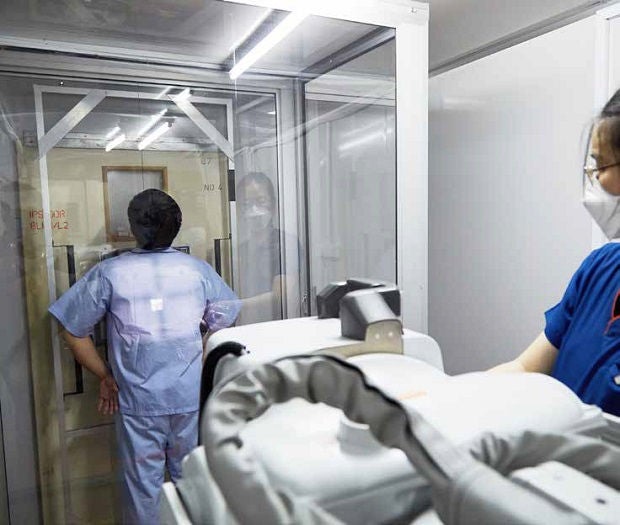
<<Dr Lim Kheng Choon was instrumental in the design and development of SG SAFE.R. Patients enter the glass box (within the mobile x-ray unit) for their scan, avoiding contact with the radiographer.>>
On a rescue-and-relief mission to tsunami-hit Medan in 2004, Dr Lim Kheng Choon saw how his medical colleagues changed lives for the better. He then decided to give up his SAF career to be a doctor.
He had a successful
career as a Republic
of Singapore Air
Force (RSAF) aircraft
mechanical engineer. But on a
tsunami relief mission to Medan in
2004, Dr Lim Kheng Choon had an
eye-opening experience that led
him to a mid-career change.
Part of the RSAF rescue-andrelief
team, the then 28-year-old
witnessed first-hand how the
medical team provided care to
critically ill patients.
“I remember we were evacuating a very seriously burnt child. Throughout the flight, the parents talked to the medical team, and I could see how grateful and relieved they were to finally get help,” said Dr Lim.
“Being a doctor, and having the ability to heal and to comfort can make a very big difference. And it got me thinking.”
Armed with a deeper sense of purpose, the engineering graduate decided to study medicine. Now a Consultant at Singapore General Hospital’s (SGH) Department of Diagnostic Radiology, Dr Lim, 45, finds common ground between his engineering background and medicine.

“Engineering is a discipline about processing and looking at things from a systemic level, and understanding how things connect and work. I think medicine is a lot like that,” he said.
Indeed, his background proved useful when the COVID-19 pandemic struck last year. He played a significant role in quickly designing a mobile x-ray unit where staff need not come into contact with patients. Although his department had considered such an idea for some time, costs were an issue.
Recalling how RSAF officers had to be inventive in the field, Dr Lim said, “When you are in a disaster area, there is no way to find an office so you just use containers, which can be moved to different places quickly.”
Similar to the idea of a photo booth, a shipping container is converted into an x-ray room with a clear polycarbonate plastic box inside. Patients enter the container and stand against one side of the clear box to have x-rays taken. Named SG SAFE.R, the booth cost about $7,000 to build. The booth, said Dr Lim, is an example of how his engineering experience adds value to his current work.
Dr Lim had considered studying medicine at university but chose engineering after getting a Singapore Armed Forces (SAF) scholarship.
In 2005, the establishment of Singapore’s first graduate medical school gave Dr Lim a chance to return to school. He and his wife were just starting a family, and although the Duke-NUS Medical School offered him a bursary, it still meant the couple would be relying on a single income for some years.
“My wife was supportive but worried. We had to make some lifestyle changes. I sold my car and downgraded our flat,” said Dr Lim, who graduated in 2011.
As a radiologist, Dr Lim helps diagnose illnesses or injuries of patients based on the imaging scans he receives from the radiographers. He considers the interaction with patients to be one of the most sacred aspects of his job.
“I always tell my junior doctors that we should not forget what we are here to do, and how we can really change lives. That little gesture, what we say, and our body language make a big difference to patients,” he said.
With three children aged between 7 and 15, Dr Lim has little time for leisure. Still, to keep fit, he jogs when he has the time.













 Get it on Google Play
Get it on Google Play